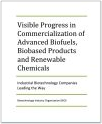What Are Biobased Chemicals:
According to the USDA, biobased products are “derived from plants and other renewable agricultural, marine and forestry materials. Biobased products generally provide an alternative to conventional petroleum derived products and include a diverse range of offerings such as lubricants, detergents, inks, fertilizers and bioplastics.”
How It Relates to Green Chemistry:
Chemists working in the biobased industry are addressing our environmentally and socioeconomically unsustainable dependence on petroleum which remains the key feedstock for a wide array of products. Biofuels are a major focus of the biobased industry, but the sector is expanding. Researchers and firms now also emphasize and commercialize bio-derived replacements for basic chemicals on which nearly every industry depends. These replacements may even be “drop-in” direct substitutes for their petroleum-derived counterparts. Developing chemical feedstocks from renewable sources and using catalytic chemistry to create high-value chemicals that replace petrochemical products is critical to achieving sustainability.
-
- Use Renewable Feedstocks – biobased chemicals can be made from a huge array of natural products, especially non-food byproducts of agriculture that may otherwise become waste.
- Catalytic enzymes can also prevent the use of hazardous chemicals and accelerate the transformation of plant waste into useful materials.
- Maximize Resource Efficiency - when designing chemicals and processes, it’s essential to consider the toll they will take on natural resources. Using biobased materials can help replace finite fossil fuels with renewables that optimize byproducts of existing industries like agriculture.
-
Computer Chips
The late Dr. Richard Wool, former director of the Affordable Composites from Renewable Sources (ACRES) program at the University of Delaware, created computer chips using chicken feathers as a key ingredient. Keratin, a protein in the feathers, was used to make a fiber form that is both light and tough enough to withstand mechanical and thermal stresses.
The result is feather-based printed circuit board that works at twice the speed of traditional circuit boards. Although this technology is still in development for commercial purposes, the research has led to other uses of feathers as source material, including for biofuel. Prof. Wool won a Presidential Green Chemistry Challenge Award for his work in 2013.
Corn-Based Plastic
NatureWorks of Minnetonka, Minnesota, makes food containers from a polymer called polylactic acid branded as Ingeo. The scientists at NatureWorks discovered a method where microorganisms convert cornstarch into a resin that is just as strong as the rigid petroleum-based plastic currently used for containers such as water bottles and yogurt pots. The company is working toward sourcing the raw material from agricultural waste.
Alternatives to Petrochemicals
Elevance Renewable Sciences won a 2012 Presidential Green Chemistry Challenge Award by using metathesis to break down natural oils and recombine the fragments into high-performance chemicals. The company makes specialty chemicals for many uses, such as highly concentrated cold-water detergents that provide better cleaning with reduced energy costs.
-
Advances in Bio-Derived Cosmetic Ingredients (The Nexus Blog, 2017)
Top Value-Added Chemicals: the Biobased Economy 12 Years Later (The Nexus Blog, 2017)
Biomass Refinery 2.0 (The Nexus Blog, 2017)
-

An Economic Impact Analysis of the U.S. Biobased Products Industry: A Report to the Congress of the USA
This 2015 report by Golden, J.S., Handfield, R.B., Daystar, J. and, T.E. McConnell is a joint publication of the Duke Center for Sustainability & Commerce and the Supply Chain Resource Cooperative at North Carolina State University.
Top Value Added Chemicals from Biomass—Volume I: Results of Screening for Potential Candidates from Sugars and Synthesis Gas
This 2004 report published by the U.S. Dept. of Energy identifies the 12 biobased chemicals that could be produced from biomaterials and serve as building blocks for the creation of various useful molecules.
Biobased chemicals—the convergence of green chemistry with industrial biotechnology
An overview of the potential barriers and drivers of biobased chemical development.
Biobased Chemicals – Value Added Products from Biorefineries
Addresses the main biobased chemicals that could be co-produced in integrated biorefinery facilities, market growth projections, and economic benefits. Report produced in 2012 on behalf of IEA Bioenergy - Task42 Biorefinery.
Lignin-based bio-oil mimic as biobased resin for composite applications
This study is an example of the generation of a lignin-based bio-oil mimic without the need of extensive and costly separations.
Visible Progress in Commercialization of Advanced Biofuels, Biobased Products, and Renewable Chemicals
In this presentation, produced in 2013 by Biotechnology Industry Organization, showcases commercial facilities development from leading industrial biotechnology companies.
Environmental Comparison of Biobased Chemicals from Glutamic Acid with their Petrochemical Equivalents
A life cycle analysis comparing four biobased and petrochemical products, demonstrating biotechnological processes based on sugar as well as amino acids.


